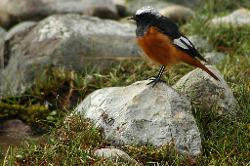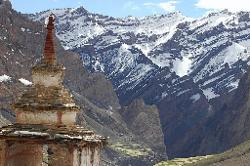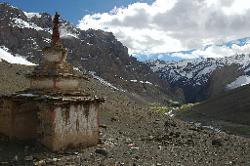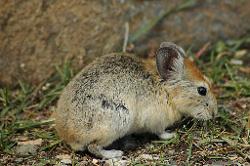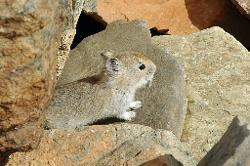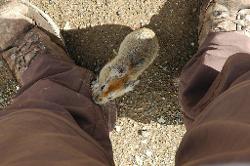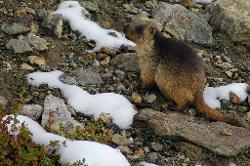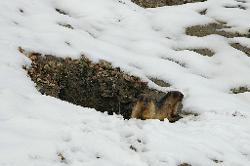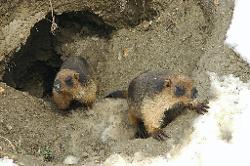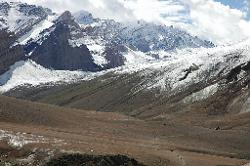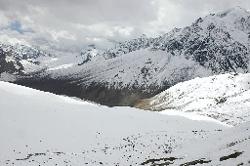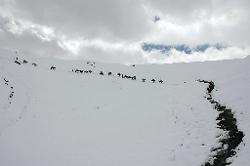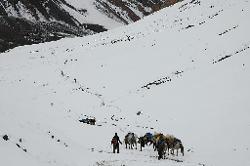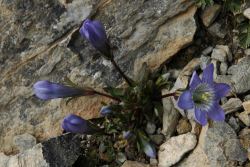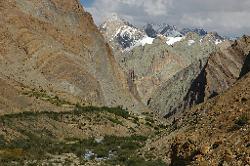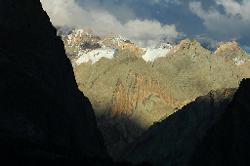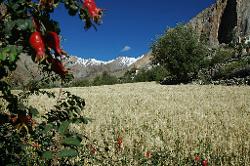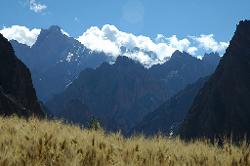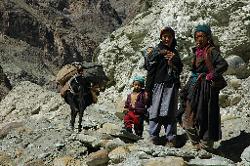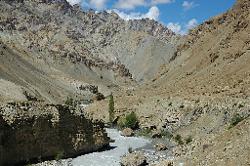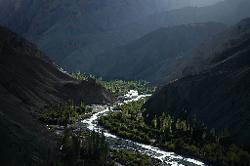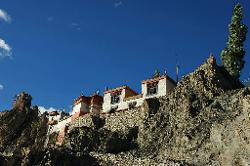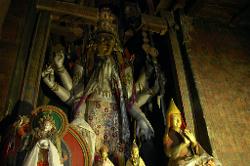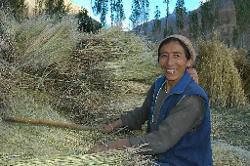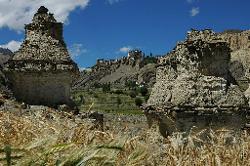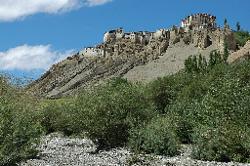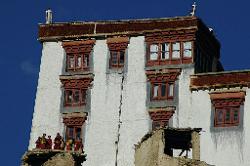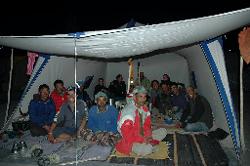MyHimalayasimpressions from |
|
|||||||
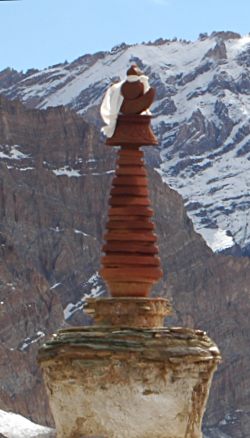
Ladakh to Zanskar: Photoskar to Lamayuru
Photoskar Rest Day (Day 21)
There's no sound in the middle of the night, did the rain finally stop? I open the tent, and a sheet of snow falls off it. But snow is better than rain, and a quick check reveals that everything in my tent is still dry.
Thick clouds in the morning remain. Heavy and wet snowflakes continue to fall for most of the day. Rivulets starts to emerge, and some serious trench-digging is necessary to ensure a dry pre-breakfast nap until noon. The clouds lift a little, but hope vanishes when the sun' disappears in clouds.
After hours in the tent, I have to go for a walk despite the rain and though it's a short stroll it is very enjoyable. The rain has turned the pebbles along the riverbed into shining colours. The green, red, black and white pebbles make for interesting still lives.
The wet ground attracts many birds, white-winged redstart, white wagtail, and a sparrow-sized bird with a yellow head, and a flock of several Common Redshank (not that I know much about birds, but Joel brought the book "Birds and Mammals of Ladakh" whose bird-section makes for a good read on a rainy afternoon. The mammal section is more interesting and highly recommended).
There's rumours of people not being able to cross passes. We just have to wait and see what the conditions will be tomorrow.
Photoskar - Sirsir La - Hanupatta (Day 22)
After breakfast the hills and mountains become visible, and are covered in snow. Fog and mist float in and out of the their faces and collect before dissolving in the blue sky. The fields and village get the sun, quite a different picture than some days ago.
From the chorten the views are spectacular, snow and rock dominates the scenery except for the terraced green and yellow fields of barley.
The nearby mani wall is home to a family of pika. They seem very eager to warm up on the stones and then get something to eat, making them much less careful than usual. I get quite close for a picture of an older one. When waiting for a young one to reappear for the mani stones, I suddenly feel something tucking at the bottom of my pants. I look down, and am astonished. A pika is tearing and nibbling at my muddy trekking pants. The sound of my camera's shutter doesn't scare it away, neither do gently movements. Finally I get it to move away, and follow the others on the way to the pass. Sirsir La rises like a white wall out of the ochre valley. The snow has mostly melted until the foot of the pass, making the ground wet and muddy.
Marmots are enjoying the sunrays after two days of nasty weather, and not careful. The young enjoy boxing matches and walk far away from their holes to nibble on some bushes. At another hole a pair disappears when I get too close. After waiting a minute right in front of the hole without moving, the braver appears from the tunnel, looks at me and gets out of its hole. The other one is more skeptical but follows reluctantly. Only when I move to get away are they surprised and disappear deep into their hole.
I'm just ahead of the horses that are quickly going up the muddy path that cuts through the white fairytale landscape. During the climb to the pass the muddy trail turns into a mudbath, a difficult ascent without walking sticks. Not very tiring, but much concentration is required to avoid a slip. I am surprised how quickly we are on top. The last two weeks have done wonders to our leg muscles.
The wind is howling, it's quite cold but a fantastic place to be and take in the grand scenery around us. Singi La lies in deep snow, the steep mountains which were barren two weeks ago are not completely covered in snow. Nothing reminds me of the colourful rock landscape, it's like a different route I've never taken before. This makes it easier to accept the fact that we can't return via the Shilla valley. The gorge is filled with much water, rockslides might occur. I am playing with the thought of going expedition-style with Lobsang, but the prospect of a very, very wet camp just across the valley stops me in the end. We'll return to Lamayuru via a well-trodden route.
The horses don't seem to have a problem with these conditions. They walk quickly down the other side, breaking a nice trail for me.
Lunch at the first snow-free spot sounds like a good idea, and then down to Honupatta. The snow intensifies the landscape in a strange way, and I enjoy the walk in the white surroundings. At the bridge the snow has melted already, catapulting me in very different world. t feels like desert again, with the molded rock pinnacles to the left and the first fields of Honupatta ahead of me. We camp at the same spot like last time. The routine "put up tent, lay out stuff, wash clothes, wash yourself" is done quickly. What now?
Lobsang mentioned that he saw ibex in a sidevalley two weeks ago. I walk high up into the valley, but don't spot any animals. When the shades become longer, I turn back and enjoy the leftover pakoras at camp.
Honupata - Wanla (Day 23)
To make the walk back a little more interesting, I leave the main trail at the village and walk through the barley at the river. Great scenery, yellow fields with a deep blue sky above. Rows of trees separate the fields, the few houses stand slightly elevated above them. Birds and lizards warm up on trees and stones. A peaceful morning, I take it easy and enjoy the best time of the day.
After the village it's a gentle walk down to the beginning of the gorge. Rock faces reach high into the sky. It's cold in the narrow spots where the sun hasn't reached the bottom of the valley yet. Not many people are on the trail; Nepali roadworkers carry heavy metal parts of a bridge to the village (and are so bewildered when I great them with "ramro cha?", they're confused and it takes some seconds until they answer "ramro cha").
After Sumdo we soon hit the road, where rain has led to rockfall and parts of the road are covered by large and small boulders. Walking on or along roads make the way always seem longer than it really is, so even tough it's is probably just an hour to Fanjila it feels never-ending, and my feet hurt a little. It's actually a nice walk in the somewhat wider valley.
A quick lunch at Fanjila where we get details about the deadly accident. The brother of the restaurant owner wanted to assist our driver Wangchuk, but our driver didn't want to take him. Anyway, he insisted and came, and got out of the car near the bridge. A few moment later a single small boulder came down from the hillside and hit his head. Our driver brought him back to the village, but nothing could be done to safe him.
The road to Wanla is not used by cars often, which makes the walk to the large village a little more enjoyable. The valley opens up more, fields appear on both sides of the river and the further down we get the more houses appear. When the old monastery appears on a hill to the right, I'm glad to know we've arrived. After three hours on the road the feet hurt, not being used to such terrain.
We find a lovely campsite near the river. Next to the housewife's well-kept garden, on a patch of harvested barley, we put up our tents in the afternoon. Later we walk up to the monastery that was being renovated recently. The mural paintings are very nice, the same goes for the large-sized statue of Avalokiteshvara. The gompa reminds me of Alchi, and later I find out it really was constructed around the same time, this means one thousand years ago.
The sun disappears behind the hills, and illuminates the side-valley that leads to Shilla. The hills disappear in the backlight and shade, while the river is a silver serpent crawling down its it bed - a great sight.
Lying on the haystack at camp is a good time and place to think of the last weeks, and the beauty of trekking in general and Ladakh in particular.
Tomorrow we'll just have a short walk to Lamayuru, so the trek feels like finished.
Wanla - Lamayuru (Day 24)
The walk towards Shilla gorge takes us up a sidevalley that is covered by bushes and trees along the creek. At a chorten we enter a tiny, dry valley to our right that doesn't really look like it leads anywhere, let alone contains a trail. It climbs gently at first, becomes quite steep in other parts and the lack of wind makes it quite a hot walk.
Mentally I finished the trek yesterday, making every step seem quite an excertion. Then we reach the last pass of our trek, the low, 3'720 m high Prinkiti La. It's hard to see where we came from, it must be from somewhere near the snow-covered peak. On the other side lies a wide valley to our left, with a valley the right that's the exit to Lamayuru. Soon we reach the first fields and see the characteristic moon landscape of yellow sediments. Colourful red-violet rock and snow-peaks of the Ladakh range add more colours to the scene.
When we reach the sandstone of the former lake and turn around the corner at three chortens, the impressive monastery of Lamayuru rises in front of us. It is built on top of a steep hillside, with parts of the old town lower on the hill, and green fields near the river.
The main assembly hall is built around a cave where the important Buddhist scholar Naropa is said to have meditated in the 11th century. In the 16th century a Ladakhi ruler was so grateful to the head lama for some services that he declared the monastery a sanctuary. If a criminal managed to reach it, he was not prosecuted. These days, unlike many of the other monasteries during this trek, Lamayuru has a large community of monks and a school for novices. The annual festivals draw large crowds. In the evenings, it's a quiet place and good time to visit.
Last dinner, and tip-ceremony plus a lottery with small handouts. The old horseman who got teased most by the crew (and who liked it least) is lucky and gets first pick. I'm glad for him, and hope that my boots will fit him.
Lamayuru - Leh (Day 25)
Wangchuk and another driver arrived yesterday evening. We leave in the morning, and reach Leh much faster I thought. It was a nice relaxed drive, and we even saw - from far far away anyway- the first (and only) blue sheep during our visit. In Leh it's great to take a hot shower, relax on a bed, and go to a restaurant for a regular dinner.
I spend the next day being lazy.
Leh - Delhi - Zurich (Day 27 / 28)
Security is extremely tight at Leh airport, no handluggage at all is allowed. We manage to get window seats, and enjoy a fantastic flight with views over Rupshu. The white lake of Tso Kar, the blue waters of Tso Moriri, and almost the entire route from my 2002 trek to Tso Moriri is clearly visible - a great bye-bye from Ladakh.
We'll have 1 1/2 days in Delhi. Thanks to the metro we spend a very relaxed shopping and eating tour in the one city which I've never really liked before, but I really enjoy it this time. Then, in the very early morning of the 10 September 2006 we leave India and arrive in Zurich, a little tired but already thinking about the next trip in the Himalayas..
|
Summary Part 7:
Luckily we have the luxury of extra days, and the next day is
spent in the comfort of my tent while wet snow continues to
fall. Fog quickly dissolves and we leave Photoskar on a
brilliant morning. Snow gets a little deeper on the way to
Sirsir La, but does not pose any problems. The walk in the warm
afternoon sun down the fertile valley to Honupatta two hours
later makes the snow of the morning seem like a distant dream.
We return the same way to Panjila along the river, and stop in
Wanla for the night. An old monastery towers above the large
village; its location as impressive as its interior. Ascending a
dry gully the next day, we cross the last of the 13 passes,
Prikti La, and soon afterwards reach the yellow barley fields of
Lamayuru. We put up tents at the foot of the famous monastery
and enjoy the last of the many fantastic dinners. The next day
we drive back to Leh. The trekking passed so quickly it is hard to believe we've been on the trail for three weeks. |
